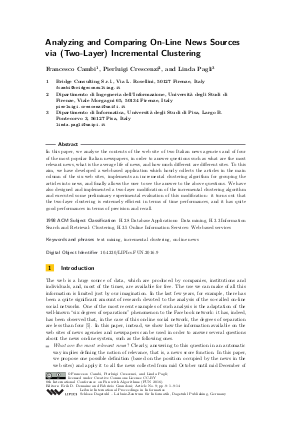Analyzing and Comparing On-Line News Sources via (Two-Layer) Incremental Clustering
Authors Francesco Cambi, Pierluigi Crescenzi, Linda Pagli
-
Part of:
Volume:
8th International Conference on Fun with Algorithms (FUN 2016)
Part of: Series: Leibniz International Proceedings in Informatics (LIPIcs)
Part of: Conference: International Conference on Fun with Algorithms (FUN) - License:
 Creative Commons Attribution 3.0 Unported license
Creative Commons Attribution 3.0 Unported license
- Publication Date: 2016-06-02
File

PDF
LIPIcs.FUN.2016.9.pdf
- Filesize: 2.52 MB
- 14 pages
Document Identifiers
Subject Classification
Keywords
- text mining
- incremental clustering
- on-line news
Metrics
- Access Statistics
-
Total Accesses (updated on a weekly basis)
0PDF Downloads0Metadata Views
Abstract
In this paper, we analyse the contents of the web site of two Italian press agencies and of four of the most popular Italian newspapers, in order to answer questions such as what are the most relevant news, what is the average life of news, and how much different are different sites. To this aim, we have developed a web-based application which hourly collects the articles in the main column of the six web sites, implements an incremental clustering algorithm for grouping the articles into news, and finally allows the user to see the answer to the above questions. We have also designed and implemented a two-layer modification of the incremental clustering algorithm and executed some preliminary experimental evaluation of this modification: it turns out that the two-layer clustering is extremely efficient in terms of time performances, and it has quite good performances in terms of precision and recall.
Cite As Get BibTex
Francesco Cambi, Pierluigi Crescenzi, and Linda Pagli. Analyzing and Comparing On-Line News Sources via (Two-Layer) Incremental Clustering. In 8th International Conference on Fun with Algorithms (FUN 2016). Leibniz International Proceedings in Informatics (LIPIcs), Volume 49, pp. 9:1-9:14, Schloss Dagstuhl – Leibniz-Zentrum für Informatik (2016)
https://doi.org/10.4230/LIPIcs.FUN.2016.9
BibTex
@InProceedings{cambi_et_al:LIPIcs.FUN.2016.9,
author = {Cambi, Francesco and Crescenzi, Pierluigi and Pagli, Linda},
title = {{Analyzing and Comparing On-Line News Sources via (Two-Layer) Incremental Clustering}},
booktitle = {8th International Conference on Fun with Algorithms (FUN 2016)},
pages = {9:1--9:14},
series = {Leibniz International Proceedings in Informatics (LIPIcs)},
ISBN = {978-3-95977-005-7},
ISSN = {1868-8969},
year = {2016},
volume = {49},
editor = {Demaine, Erik D. and Grandoni, Fabrizio},
publisher = {Schloss Dagstuhl -- Leibniz-Zentrum f{\"u}r Informatik},
address = {Dagstuhl, Germany},
URL = {https://drops.dagstuhl.de/entities/document/10.4230/LIPIcs.FUN.2016.9},
URN = {urn:nbn:de:0030-drops-58777},
doi = {10.4230/LIPIcs.FUN.2016.9},
annote = {Keywords: text mining, incremental clustering, on-line news}
}
Author Details
References
-
J. Azzopardi and C. Staff. Incremental Clustering of News Reports. Algorithms, 5:364-378, 2012.

-
D. Bhattacharya and S. Ram. Sharing News Articles Using 140 Characters: A Diffusion Analysis on Twitter. In IEEE/ACM International Conference on Advances in Social Networks Analysis and Mining, pages 966-971, 2012.

-
Jon Borglund. Event-Centric Clustering of News Articles. Technical report, Department of Information Technology, University of Uppsala, 2013.

-
T.F. Cox and M.A.A. Cox. Multidimensional Scaling (2nd ed.). Chapman and Hall, 2000.

- S. Edunov, C.G. Diuk, I.O. Filiz, S. Bhagat, and M. Burke. Three and a half degrees of separation, 2016. URL: http://research.facebook.com/blog/.
-
R. Fagin, R. Kumar, and D. Sivakumar. Comparing Top K Lists. In Proceedings of the 14th Annual ACM-SIAM Symposium on Discrete Algorithms, pages 28-36, 2003.

-
M. Kendall and J. D. Gibbons. Rank Correlation Methods. Edward Arnold, 1990.

-
J. Leskovec, A. Rajaraman, and J.D. Ullman. Mining of Massive Datasets. Cambridge University Press, 2014.

-
Vladimir I. Levenshtein. Binary codes capable of correcting deletions, insertions, and reversals. Soviet Physics Doklady, 10:707-710, 1966.

-
J.B. Lovins. Development of a Stemming Algorithm. Mechanical Translation and Computational Linguistics, 11:22-31, 1968.

- Parse.ly. What is the Lifespan of an Article?, 2015. URL: http://parsely.com.
-
G. Petkos, S. Papadopoulos, and Y. Kompatsiaris. Two-level Message Clustering for Topic Detection in Twitter. In SNOW 2014 Data Challenge co-located with 23rd International World Wide Web Conference, pages 49-56, 2014.

- Wikipedia - News Agency. URL: https://en.wikipedia.org/wiki/News_agency.
